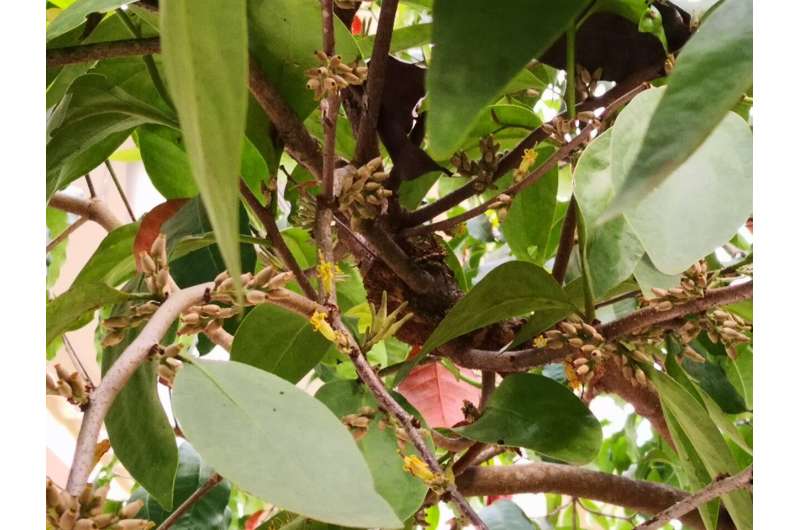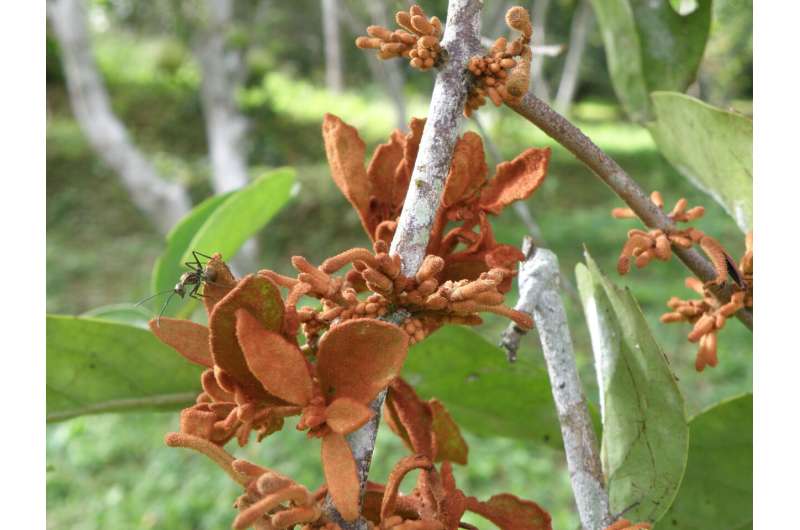This article has been reviewed according to Science X's editorial process and policies. Editors have highlighted the following attributes while ensuring the content's credibility:
fact-checked
peer-reviewed publication
trusted source
proofread
Mistletoe nutrient concentrations found to mainly depend on host nutrients

Mistletoes are obligate hemiparasitic aerial shrubs and play important roles in biogeochemical cycles. They obtain mineral nutrients and water from their hosts via haustoria that penetrate host vascular tissues. Although many studies have compared nutrient concentrations between mistletoes and their hosts, no general patterns have been found and the nutrient uptake mechanisms in mistletoes have not been fully resolved.
In a study published in New Phytologist, researchers from the Xishuangbanna Tropical Botanical Garden (XTBG) of the Chinese Academy of Sciences have investigated the water and nutrient relations in mistletoes compared with their hosts.
They presented the first regional data on 11 nutrient elements, two isotope ratios, and two leaf morphological traits of 121 mistletoe-host species pairs (a total of 344 individual pairs) sampled from four sites (Lijiang, Ailaoshan, Xishuangbanna, and Yuanjiang) in Yunnan Province, southwest China, in which there are distinct differences in water availability and temperature/climate.
The researchers found that mistletoe nutrient concentrations mainly depend on host nutrients, but other factors, such as environmental conditions, host life-history classification and mistletoe morphological traits also play important roles for some nutrients.
Specifically, mistletoes had significantly higher phosphorus, potassium, and boron concentrations, nitrogen isotope ratio, but lower water-use efficiency indicated by lower carbon isotope ratio (δ13C). Other elements were similar to those in hosts. Sites explained most of the variation in the multidimensional trait space. With increasing host nitrogen concentration, both mistletoe δ13C and the difference between mistletoe and host δ13C increased.

Therefore, host nutrient concentrations were the best predictors for that of the mistletoe nutrient elements in most cases. Mistletoe and host species explained a large proportion of the variation in mistletoe nutrient elements, stable isotope ratios and leaf morphological traits.
The findings shed light on the importance of combining sites, species, transpiration related parameters, host life-history traits in understanding the water and nutrient relations of mistletoes and nutritional interactions between mistletoes and hosts.
"To mistletoes, you are what you eat, because host nutrients and environment mainly determine the nutritional contents of mistletoes," said Zhang Jiaolin of XTBG.
More information: Yun‐Bing Zhang et al, You are what you eat: nutrient and water relations between mistletoes and hosts, New Phytologist (2023). DOI: 10.1111/nph.18747
Journal information: New Phytologist
Provided by Chinese Academy of Sciences




















